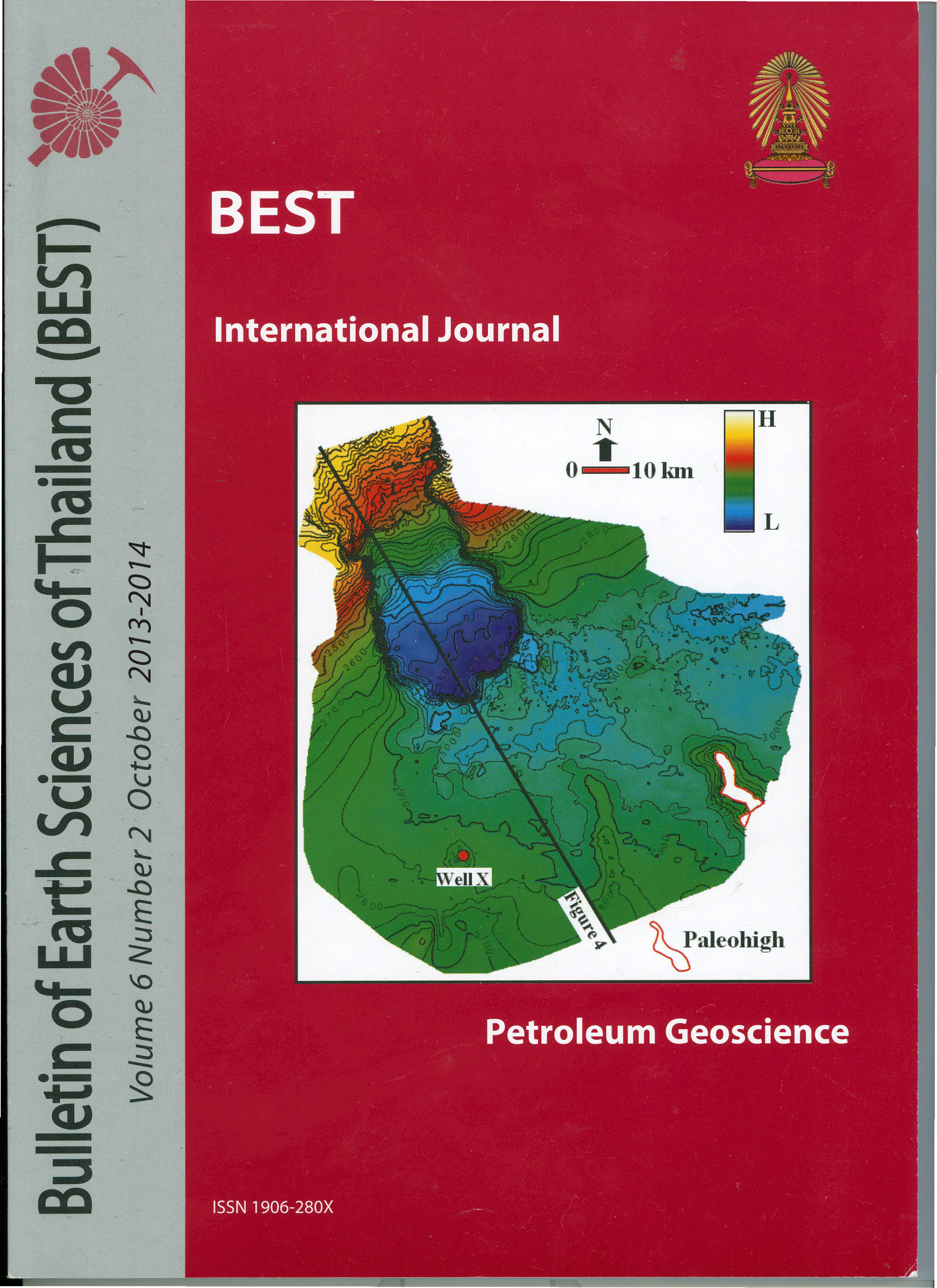Diagenetic Evolution of “Buried-Hill” Carbonate Reservoir Analogs in Outcropping Permian Carbonates, Saraburi Province, Thailand
Main Article Content
Abstract
In order to better understand controlling factors on karstification in central Thailand, field and laboratory studies are conducted on two geographically-separate karstified Permian carbonate outcrops. Using field observations, along with detailed petrographic and stable isotopic determinations, the aim is develop better relevant local analogs for the fluid and structural evolution system that created the economic porosity in producing “buried-hill” carbonate reservoirs in subsurface of Thailand.
Both studied outcrops are in inactive quarries in Saraburi province, and the two regions show somewhat different effective porosity distributions in the karst, both of which are controlled by the permeability contrasts present at the time the karst was forming. One set of permeability contrasts is related to compactional bedding orientation, with bedding-parallel stylolites controlling karstification. This creates sub-horizontal vugs oriented parallel to bedding. The other set of controls is a combination of inclined bedding and conjugate fractures. This is related to permeability contrasts created by fracture and fault-damage zones that were created during thrusting and uplift. Many of the documented karst features preserve textural
evidence of recent meteoric karst formation and these are features with preservation potent and so their remnants are recognizable in ancient counterparts. These “pointer” textures include a range of characteristic speleothems and soils; terra rossas, collapse breccias, stalactites, stalagmites and a variety of flowstones.
The integration of outcrop observations, petrography and isotope study reveals a diagenetic history that, in addition to its modern telogenetic overprint, includes textural and isotopic evidence of the effects of earlier burial-related hydrothermal fluids. This subsurface diagenesis included one or more episodes of mesogenetic vug formation, but these features are now mostly filled with burial cements. Therefore, most open-cavities in the study outcrops formed in the modern telogenetic environment, ultimate driven by uplift tied to the Himalayan Orogeny.
Plotting of δ18O/16O and δ13C/12C shows two distinct plot field trends, that can also be recognized in a studies of drill cuttings in subsurface counterparts. The isotope plot field trends are: 1) a burial trend typified by increasingly negative oxygen values, related to the increasing temperatures of ongoing burial and 2) a mete or ic-mixing trend related to negative carbon residing in soil gases passing into in meteoric waters, which then precipitate speleothem calcite in the uplifted rock and fissures. The burial trend relates to fracture development, stylolite formation, hydrothermal flushing and thrust-related calcite veins and cements. The meteoric-mixing trend relates to collapse breccias and speleothem formation in the modern karst zone.
Article Details

This work is licensed under a Creative Commons Attribution-NonCommercial-NoDerivatives 4.0 International License.
Copyright © 2008 Department of Geology, Faculty of Science, Chulalongkorn University. Parts of an article can be photocopied or reproduced without prior written permission from the author(s), but due acknowledgments should be stated or cited accordingly.
References
Ampaiwan, P., 2011, Structural developments of thrusts, folds and fractures in quarry exposures of Permian limestones, Saraburi Province, Central Thailand; Implication for fractures reservoir development in NE Thailand, Petroleum Geoscience Department, Bangkok, Chulalongkorn University, Master Degree. 44 p.
Dawson, O. and Racey, A., 1993, Fusuline-caleareous algal biofacies of the Permian Ratburi Limestone, Saraburi, Central Thailand, Journal of Southeast Asian Earth Sciences, Vol. 8, Nos 1-4, Great Britain, p. 49-65.
Hoefs, J., 2009, Stable isotope geochemistry, Springer, Berlin, Germany, 285 p.
Kuenphan, N., 2012, Structural developments of thrusts, folds and fractures in quarry exposures of Permian limestones, Pak Choong, Nakhon Ratchima Province, Central Thailand; Implication for fractures reservoir development in NE Thailand, Petroleum Geoscience Department, Bangkok, Chulalongkorn University, Master Degree, 41 p.
Racey, A., 2011, Petroleum geology, in Ridd, M.F., Barber, A.J., Crow, M.J. (Eds.), The Geology of Thailand, Geological Society, London, p. 507–537.
Thanudamrong, S., 2011, Structural style and fracture characteristics of thrust and folded Permian carbonates in the Siam City Cement company quarry, Tabkwang, Saraburi Province, Central Thailand; Analogs for fractured carbonates, Petroleum Geoscience Department, Bangkok, Chulalongkorn University, Master Degree, 61 p


